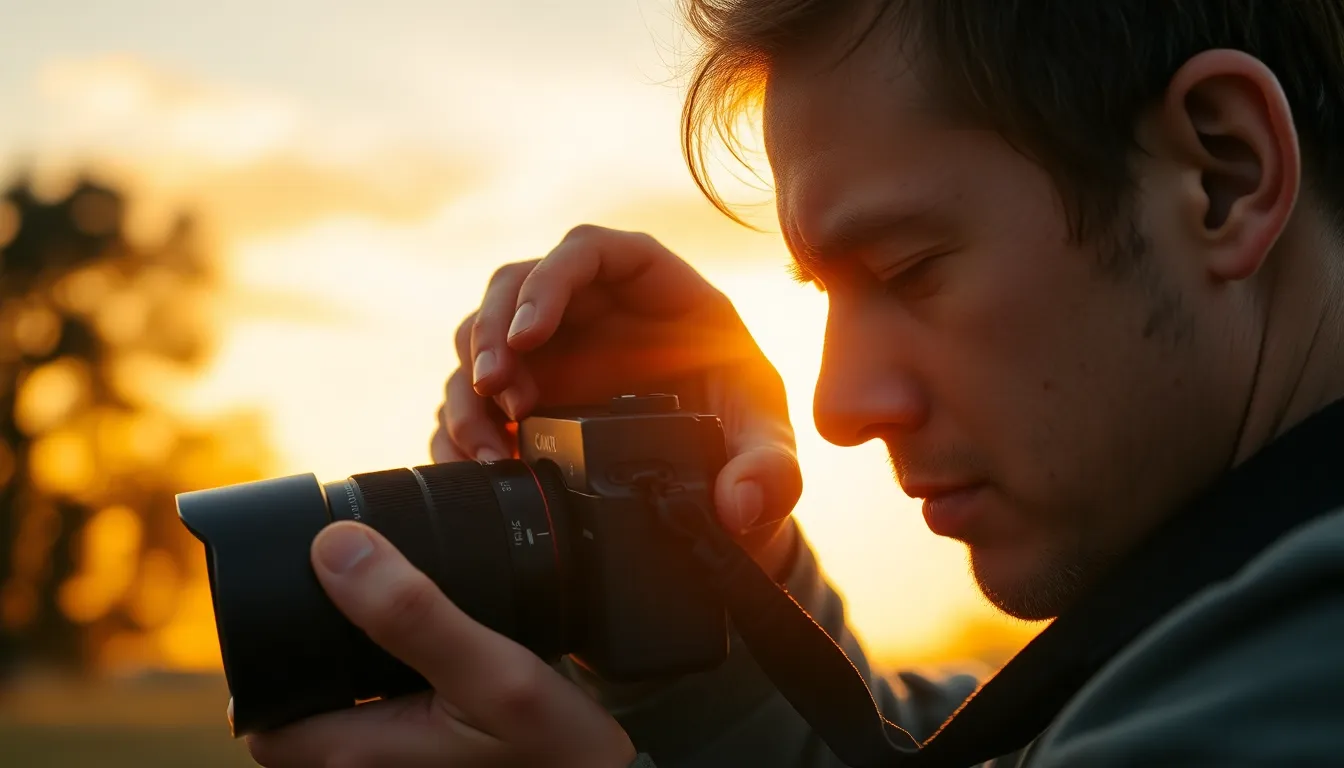Table of Contents
TogglePhotography isn’t just about pointing and shooting; it’s an art form that can turn the mundane into the magnificent. Whether it’s capturing a sunset that makes you feel like a poet or snapping a candid moment that’ll make Grandma laugh, mastering a few simple tips can elevate anyone’s photography game.
Essential Photography Tips for Beginners
Mastering photography requires knowledge of essential techniques and tools. These tips help beginners enhance their skills and capture stunning images.
Understanding Your Camera Settings
Familiarizing yourself with your camera settings is crucial for taking better pictures. Adjusting the aperture controls light exposure and depth of field, influencing how images appear. Shutter speed affects motion capture; faster speeds freeze action while slower speeds create motion blur. ISO settings determine sensitivity to light, with higher values useful in low-light conditions. Learning to balance these settings enhances image quality. Experimenting with manual mode encourages a deeper understanding of photography, allowing creative expression.
Composition Basics
An effective composition draws viewers’ attention and communicates a story. Rule of thirds suggests dividing the frame into a grid and placing key elements at intersections for a balanced look. Leading lines guide the eye through the image, creating depth and interest. Framing uses natural elements to highlight focal points, while symmetry can produce visually appealing structures. Negative space allows subjects to breathe and promotes emphasis. Applying these composition techniques transforms ordinary scenes into captivating photographs.
Advanced Photography Tips

Advanced photography demands a deep understanding of techniques and creativity. The following tips enhance skills and elevate photographic work.
Playing with Lighting
Natural light serves as a key element in photography. Shooting during golden hours—just after sunrise or just before sunset—produces soft, warm tones. Using reflectors effectively illuminates subjects, minimizing harsh shadows. Experimenting with artificial light sources, like flashes or LEDs, offers complete control over scenes. Incorporating backlighting creates dramatic silhouettes, lending a mysterious quality to images. Understanding and manipulating shadows can also add depth and dimension, enabling captivating compositions.
Mastering Focus Techniques
Achieving sharp focus significantly impacts image quality. Manual focus provides precision, especially with macro photography. Utilizing depth of field allows for selective focus, bringing the main subject into sharp relief while blurring the background. Employing techniques like focus stacking enhances detail in challenging lighting conditions. Utilizing the rule of thirds aids in composing well-balanced shots, guiding the viewer’s eye effectively. Ensuring focus points align with subject matter emphasizes the story behind each photograph.
Creative Photography Tips
Creative photography adds depth and intrigue to images. By implementing unique techniques, photographers can capture extraordinary shots that stand out.
Experimenting with Perspectives
Changing the angle can transform a photograph. Shooting from above or below often yields fresh viewpoints that engage viewers. Additionally, using wide-angle lenses can create dramatic effects. Capturing reflections or framing through objects enhances the composition. Photographers should also consider incorporating foreground elements to add depth. Exploring unusual vantage points encourages creativity and invites unique narratives.
Utilizing Props and Backdrops
Incorporating props can tell a story or highlight a subject. Everyday items, like fabric or household objects, can add personality to an image. Choosing backdrops that complement the subject creates a cohesive look. Natural environments, urban settings, or textured surfaces provide visual interest. Photographers can also experiment with colors and patterns in props. Creativity shines through when blending elements for striking visual presentations.
Post-Processing Tips
Post-processing enhances the artistry in photography. It allows photographers to refine their images and emphasize storytelling.
Editing Software Recommendations
Adobe Lightroom stands out as a popular choice, offering advanced organizational tools and powerful editing features. Capture One provides enhanced color grading capabilities, appealing to those who prefer a tailored editing experience. For a more budget-friendly option, GIMP serves well with its extensive features similar to Photoshop. Affinity Photo attracts users seeking a professional alternative without subscription fees. Each software option caters to different needs while delivering quality adjustments.
Common Editing Techniques
Cropping can greatly enhance composition, focusing attention on the subject. Adjusting exposure balances light and shadow in an image. Utilizing curves and levels improves contrast, bringing out details. Color correction helps achieve accurate hues and maintains a natural look. Sharpening enhances clarity, accentuating textures and edges. These techniques contribute to transforming raw images into striking visual narratives.
Photography is a powerful medium that allows individuals to express their creativity and capture life’s fleeting moments. By applying the tips shared throughout the article, photographers can elevate their skills and transform their images into compelling stories.
Whether it’s mastering camera settings, exploring composition techniques, or embracing the art of post-processing, every step taken enhances the overall quality of their work.
As photographers continue to experiment and refine their craft, they’ll discover unique perspectives and styles that resonate with their vision. Embracing these insights will not only improve their photography but also deepen their appreciation for the art form itself.







